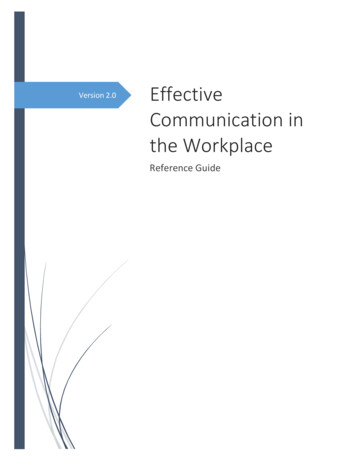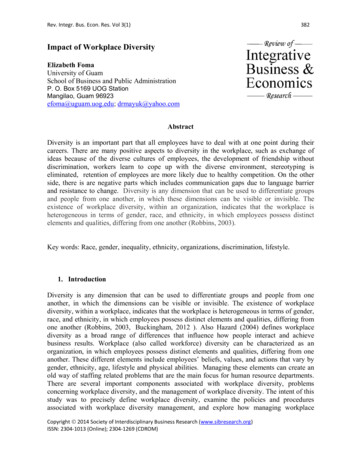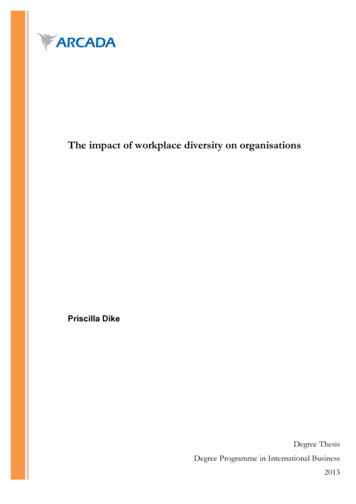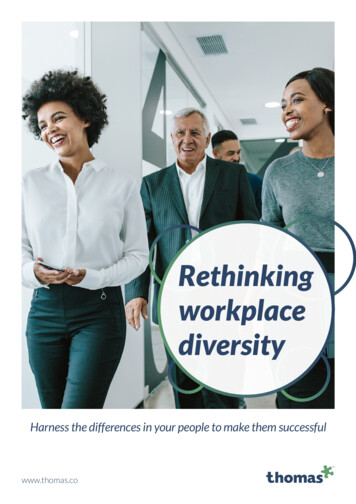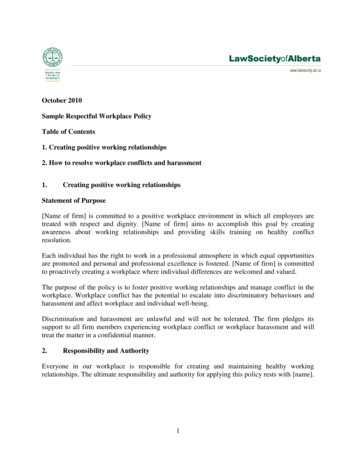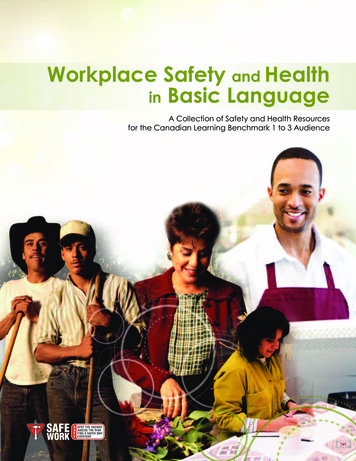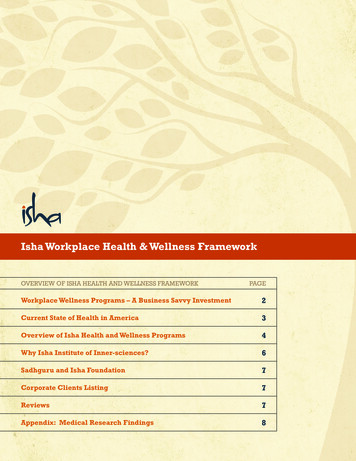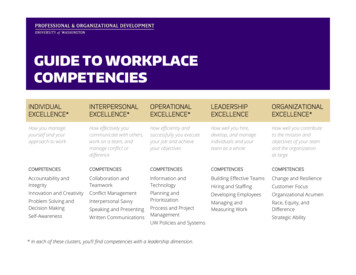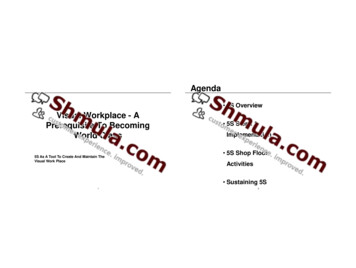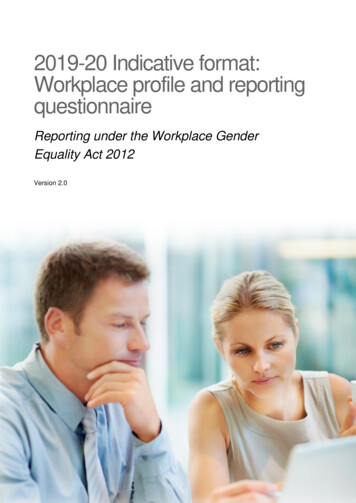
Transcription
2019-20 Indicative format:Workplace profile and reportingquestionnaireReporting under the Workplace GenderEquality Act 2012Version 2.0Workplace Gender Equality Agency 2019-20 Indicative format: workplace profile and reporting questionnaire1
Changes to the indicative format for 2019-20Change madepage/sectionUpdated title and wording from Reference Guide to Guide to Reportingsection. This section replaces the previous Reference Guide document.page 4Q 1.11 – question and table text amendedpage 17Q 2.1 b – question amendedpage 19Q 4.1 – option “Set targets to reduced any like-for-like gaps” removedpage 24Workplace Gender Equality Agency 2019-20 Indicative format: workplace profile and reporting questionnaire2
Section 1: OverviewUnder the Workplace Gender Equality Act 2012 (Act) relevant employers arerequired to complete and submit a report covering standardised reportingmatters under six gender equality indicators (GEIs). The format of this reportincludes a workplace profile and a reporting questionnaire. Workplace profile: The workplace profile reflects data required under gender equality indicators one(GEI 1: gender composition of the workforce) and three (GEI 3: equal remuneration between womenand men) and is in an Excel format. Reporting questionnaire: The reporting questionnaire reflects data required under all six genderequality indicators and includes 17 questions. Response options in the reporting questionnaire aretypically a yes/no or table format. Where ‘no’ is selected, employers have the option to provide areason for this by either selecting from a series of provided options or via a free-text box.About this documentRelevant employers are required to complete and submit their report online using the Workplace GenderEquality Agency’s (Agency) secure online portal. To assist relevant employers to prepare for reporting in2020, this document provides the indicative format of the: workplace profile in Section 2 reporting questionnaire in Section 3.Relevant employers can get ready for reporting as follows: workplace profile – start preparing data by using excel worksheeets provided by the Agency.(Remember, when you actually start reporting online, you will have to download the system generatedtemplate from the reporting portal, then populate, upload and submit that document, not theworksheets.) reporting questionnaire – relevant employers can start planning their responses and gathering data forthe questions set out in the reporting questionnaire. Note that the questionnaire format in Section 3 ofthis document is indicative only. It is not the reporting template.Overview of reporting under the ActFor information on the Agency and reporting under the Act please refer to the Quick guide to reporting andcompliance located on the Agency’s website at www.wgea.gov.au .Minimum standardsMinimum standards relate to specified gender equality indicators (GEIs) and are set by the Minister in theWorkplace Gender Equality (Minimum Standards) Instrument 2014.Minimum standards represent the standard needed to achieve a particular objective under a GEI. To meetthe minimum standard, relevant employers with 500 or more employees (in total within the corporatestructure) must have a policy or strategy in place that specifically supports gender equality in relation to one,or more, of the following GEIs. The related questions in the reporting questionnaire are also detailed below. GEI 1: gender composition of the workforce:‘Yes’ to having a policy or strategy for any of the options 1.1 to 1.9OR GEI 3: equal remuneration between women and men:‘Yes’ to having a policy or strategy for question 3 and yes to 3.1.ORWorkplace Gender Equality Agency 2019-20 Indicative format: workplace profile and reporting questionnaire3
GEI 4: availability and utility of employment terms, conditions and practices relating to flexibleworking arrangements for employees and to working arrangements supporting employees withfamily or caring responsibilities:‘Yes’ to having a policy or strategy for question 10.OR GEI 6: any other matters specified by the Minister in a legislative instrument: sex-basedharassment and discrimination:‘Yes’ to having a policy or strategy for question 16.If an employer that is required to meet a minimum standard does not do so, it will have a further tworeporting periods to improve against the minimum standard before it may be deemed non-compliant by theAgency.For example, for employers who reported in 2017-18 and 2018-19 that they did not have a formal policy orstrategy in place in one of the above GEIs, and report in 2019-20 that one has still not been put in place,they may be non-compliant with the Act.For more details on meeting minimum standards, refer to resources provided in the ‘Minimum standards’section of the website.Competitor Analysis Benchmark Reports and data qualityStandardised reporting under the Act enables the Agency to provide relevant employers with customisedconfidential Competitor Analysis Benchmark Reports as well as aggregated national public industrybenchmark data.Critical to the provision of quality Competitor Analysis Benchmark Reports (CABRs) is the reliability of dataprovided by employers through the reporting process. To ensure the CABRs are meaningful and comparableover time it is essential that employers take care to accurately: classify their employees to manager and non-manager categories calculate remuneration data as indicated in the workplace profile (for corporate structures, this mustbe done in relation to each employing entity in the group – refer to the Guide:Entity level reporting forcorporate structures & requirements for combined reports. ensure responses in the reporting questionnaire reflect shared industry interpretations of key conceptsand terms within your industry.Note that the online system will perform a validation of the data and inform you of possible data entry errors,or possible data quality errors.Guide to ReportingThis Indicative format is a companion document to the Guide to Reporting section on the Agency’s website.The Guide to Reporting section of the website provides employers with detailed information required forreporting, including key terms and definitions and guidance for engaging with key stakeholders within theirorganisation.ConfidentialityInformation relating to remuneration included in a report will not be published by the Agency unless writtenpermission from the relevant employer has been provided. Remuneration data may be published in anaggregated form so long as it does not disclose information about a specific employer or person. This willenable the Agency to collect and analyse data and to develop other resources on pay equity to benefitemployers. Please refer to the WGEA protocol on sharing reporting data section on our website.Workplace Gender Equality Agency 2019-20 Indicative format: workplace profile and reporting questionnaire4
Section 2: Workplace profileRelevant employers are required to complete a workplace profile. Theworkplace profile reflects data required under GEI 1 (gender composition ofthe workforce) and GEI 3 (equal remuneration between women and men).A workplace profile must include: actual headcount (that is, the actual number of employees, not full-time equivalents) of all employees(including full-time, part-time, individuals on a fixed-term contract and casuals) data which reflects your workforce at a point in time within the 2019-20 reporting period (1 April 2019 to31 March 2020). You may choose to use data based on the financial year that concludes during thereporting period. For example, you may choose to use data as at 30 June 2019.The following information needs to be provided in the workplace profile which is in an Excel format: WGEA-defined standardised occupational categories for managers and non-managers for managers only: reporting level from the CEO/head of business (or equivalent) gender graduate/apprentice employment status: full-time permanent/ongoing full-time contract (fixed-term) part-time permanent/ongoing part-time contract (fixed-term) casual. remuneration: annualised, full-time equivalent base salary and, annualised, full-time equivalent total remuneration.Selecting unit level or aggregated dataThe workplace profile may be provided to the Agency as either unit level data or aggregated data. Table 1below provides a summary of the differences between the two options. Remember, you only have to chooseONE of these options. If you use the unit level data template, the system will automatically generateaggregated tables for you to review.For both options, we recommend you prepare your data offline by populating the 2020 workplace profileworksheets available from the website. This allows you to sort, find or replace data if needed. The systemgenerated workplace profile template via the online portal is encrypted and does not allow you to sort, findor replace data. Data from your worksheets can be copied and pasted into the system-generated template.Table 1: Differences between unit level data and aggregated dataOption 1: Unit level dataSimplest option, one table to complete.One employee per line (de-identified employeedata).Option 2: Aggregated dataTwo tables to complete: one for managers, one fornon-managers*.*This is because the reporting level to the CEO/head of businessis only required for managers. Graduate and apprenticecategories only apply to non-managers.Workplace Gender Equality Agency 2019-20 Indicative format: workplace profile and reporting questionnaire5
Option 1: Unit level dataOption 2: Aggregated dataOnce uploaded, the online system generates theaggregated tables from your unit level data andautomatically calculates the relevant remunerationtotals.Employers need to calculate: aggregated employee numbers per category aggregated AVERAGE base salary and totalremuneration per category.Important note: the public report only displays the workplace profile as aggregated tables, and does notcontain remuneration data.Workplace Gender Equality Agency 2019-20 Indicative format: workplace profile and reporting questionnaire6
Option 1: 2019-20 unit level data templateTable 2 shows the layout of the Excel table if an employer decides to provide unit level data. Each line in the table represents one employee. Employee names andidentification numbers are not required in the Excel template you submit online. If they are included, they will not be published in your public and confidential reports.However, you may wish to include them in your own worksheets.When completing your workplace profile, ensure you are following the data entry requirements provided in the column headings. The columns are numbered toreflect the columns referred to in validation error reports downloaded online during the workplace profile upload process.Table 2: Unit level data templateWorkplace Gender Equality Agency 2019-20 Indicative format: workplace profile and reporting questionnaire7
Option 2: 2019-20 aggregated data templateIf an employer decides to provide workplace profile data at an aggregated level, two tables will need to becompleted: one for managers (refer layout in Table 3) one for non-managers (refer layout in Table 4).For each category, remuneration data MUST be averaged for each category (i.e. NOT the total amount foreach category).Please note that based on the information you provide, the aggregated template for managers is customisedby the system for your organisation and will therefore include the provided number of ‘Reporting levels to theCEO’ for each manager category. The following tables are examples only.The subtotal and overall total of employees will auto-calculate.The columns are numbered to reflect the columns referred to in validation error reports downloaded onlineduring the workplace profile upload process.Table 3: All managers – aggregated data templateWorkplace Gender Equality Agency 2019-20 Indicative format: workplace profile and reporting questionnaire8
Table 4: All non-managers – aggregated data templateWorkplace Gender Equality Agency 2019-20 Indicative format: workplace profile and reporting questionnaire9
Standardised occupational categories of managers and non-managersTo enable comparability, including for the Competitor Analysis Benchmark Reports, employers are requiredto classify and report on their workforce against WGEA-defined standardised occupational categories asoutlined in the Workplace Gender Equality (Matters in relation to Gender Equality Indicators) Instrument2013 (No.1). The non-manager categories mirror the major groups in the classification structure theAustralian and New Zealand Standard Classification of Occupations (ANZSCO) managed by the AustralianBureau of Statistics (refer Table 6 below).Standardised occupational categories of managersManagers are categorised as below and defined in Table 5: CEO/head of business (or equivalent) KMP (key management personnel) other executives/general managers senior managersIMPORTANT: When allocating employees toan occupational category, use the definitionfor each category as outlined in Tables 5 and6 rather than referring to job titles. other managers.Table 5: Workplace profile: standardised occupational categories of managersPlease note: a manager does not need to be responsible for people to be defined as a manager. Also notethat a supervisor is not a manager. As such, employees in this category within your organisation need to beclassified according to one of the eight standardised non-manager categories provided in Table 6.ManagersDefinition The CEO/head of business (or equivalent) refers to the head of business inAustralia, and is reported on separately to other key management personnel. For(Chief executivecorporate structures with one or more relevant subsidiaries, the definition of CEOofficer or equivalent)includes the head of business for each relevant subsidiary in Austra
One employee per line (de-identified employee data). Two tables to complete: one for managers, one for non-managers*. *This is because the reporting level to the CEO/head of business is only required for managers. Graduate and apprentice categories only apply to non-managers. Workplace Gender Equality Agency 2019-20 Indicative format: workplace profile and reporting questionnaire 6 Option 1 .

